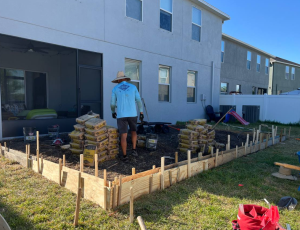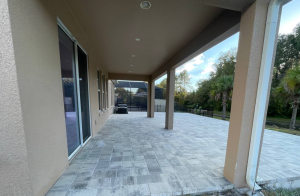Installing edging is one of the most crucial steps in building a paver driveway, yard, or pathway. Setting a border around your pavers is important, not only for their aesthetics but also to ensure structural integrity. Learn the best paver edging ideas in this article as we explore different options to help you choose the ideal edging for your project.
Let’s Get Started on Your Dream Project
813-893-8485
Why Use Edging
The creation of boundaries around an outdoor paved space addresses specific issues. It prevents the tiles from spreading and moving, which can be caused by extreme weather conditions, driving or walking on uneven ground, or even just being pushed around. Once a few tiles start to move, it can cause a cascade of destruction. The tiles crack, shift, and sink. Weeds and moss will grow in between. If you want your garden or driveway to look nice, it’s best to choose the right edging before you lay bricks or tiles. Exploring various paver edging ideas can help you find the best solution to ensure stability and aesthetic appeal. It would be a lot of work and expense to fix paver movement.
Is paver edging necessary? Yes, of course. If you frame your patio, drive, or pathway, it will give your property a beautiful visual appearance. With the right perimeter edge restraints in place, this will protect your investment and help to save money on repairs in the future.
How to choose a Paver Edge Restraint
There is no perfect edge restraint for paving. Everything depends on how you use the paver or the sub-base. Problems can arise when the edge restraint is not designed for its intended application, or when it is installed improperly. Be sure that the edge restraints are sized to fit your base. Also, pay attention to its thickness. There are many types of paver edges: concrete, stone, plastic and aluminum. Consider the pros and disadvantages of each type and what factors can influence your decision.
Walls and Edging Stones
If your pavers will be laid against a wall, building or curb that is fixed in place, you do not need an edge restraint. Installing vertical edging stone will help to retain paver tiles against landscape beds, turf or other surfaces. You can also embed them in concrete. Remove the first layer of foundation for your pavers, and replace it with concrete. Install the framing stone frames after wetting them in water to improve their adhesion with concrete. After completing these steps, apply one of the restraints below to help support your tiles as well as edging stones.
Plastic
Plastic is a popular material used for edge restraints. You may see them at DIY stores, or while walking on pavers. In areas with heavy traffic or extreme weather, plastic edge restraints may not perform as intended. Extreme weather conditions can cause some failures. Incorrect compaction of base can cause deformation to plastic framing. A common problem is the installation of the base too high, without scraping the foundation layer enough. This exposes the supporting structure.
Plastic edge restraints are installed using landscape nails or spikes that are driven into the subbase. They are used mostly in non-vehicular applications.
Metal
This option can be a little more expensive than plastic and is usually used by professionals, rather than homeowners. It is more durable than plastic alternatives. This material is best used in straight sections rather than curved ones.
Concrete Edging for Pavers
Concrete paver edging is a popular option due to its strength and durability. There are two types of concrete edging: with or without reinforcement elements. Reinforced concrete edging is generally stronger and more resistant to wear and tear. Concrete is an excellent choice for edging because it provides a solid and moisture-resistant border that adheres well to both paver tiles and the base. It’s particularly recommended for vehicular applications, as it can withstand the weight of cars and other heavy loads.
One of the downsides of concrete edging is its tendency to crack over time, especially in areas that experience freezing and thawing cycles. However, this can be mitigated by adding reinforcement elements, such as fiber mesh or rebars, to the concrete mix. These additions help to strengthen the edging and prevent cracking, ensuring a longer-lasting solution.
Concrete also offers flexibility in terms of design. It can be shaped to fit any pathway, including curves, making it a versatile choice for intricate designs. Additionally, concrete edging is relatively affordable, making it an attractive option for many landscaping projects.
The conclusion of the article is:
In this article, we’ve explored several paver edging ideas. When choosing the best material for your project, consider the paver application, material, base, climate, and budget. By selecting the right edging and incorporating reinforcement where needed, you can ensure a durable, long-lasting solution that minimizes the need for repairs.







